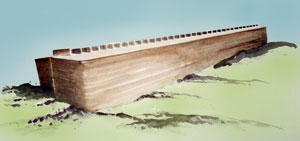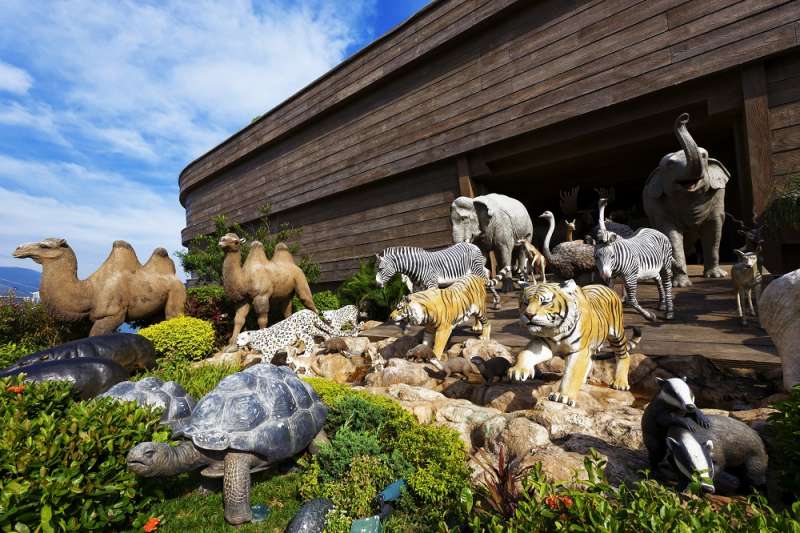
The Bible specifies Noah’s Ark as 300 cubits long, 50 cubits wide and 30 cubits high, a huge, stable, seaworthy vessel.
Many skeptics assert that the Bible must be wrong, because they claim that the Ark could not possibly have carried all the different types of animals. This has persuaded some Christians to deny the Genesis Flood, or believe that it was only a local flood involving comparatively few local animals. But they usually have not actually performed the calculations. On the other hand, the classic creationist book The Genesis Flood contained a detailed analysis as far back as 1961.1 A more detailed and updated technical study of this and many other questions is John Woodmorappe’s book Noah’s Ark: a Feasibility Study. This article is based on material in these books plus some independent calculations. There are two questions to ask:
- How many types of animals did Noah need to take?
- Was the ark large enough to hold all the required animals?
How many types of animals did Noah need to take?
Another problem often raised by atheists and theistic evolutionists is ‘how did disease germs survive the flood?’ … In fact, even now many germs can survive in insect vectors or corpses, or in the dried or frozen state, or be carried by a host without causing disease. Finally, loss of resistance to disease is consistent with the general degeneration of life since the Fall.
The relevant passages are Genesis 6:19–20 and Genesis 7:2–3.
Genesis 6:19–20:
‘And of every living thing of all flesh, you shall bring two of every sort into the ark to keep them alive with you. They shall be male and female. Of the birds according to their kinds, and of the animals according to their kinds, of every creeping thing of the ground, according to its kind, two of every sort shall come in to you to keep them alive.’
Genesis 7:2–3:
‘Take with you seven pairs of all clean animals, the male and his mate, and a pair of the animals that are not clean, the male and his mate, and seven pairs of the birds of the heavens also, male and female, to keep their offspring alive on the face of all the earth.’
In the original Hebrew, the word for ‘beast’ and ‘cattle’ in these passages is the same: behemah, and it refers to land vertebrate animals in general. The word for ‘creeping things’ is remes, which has a number of different meanings in Scripture, but here it probably refers to reptiles.2 Noah did not need to take sea creatures3 because they would not necessarily be threatened with extinction by a flood. However, turbulent water would cause massive carnage, as seen in the fossil record, and many oceanic species probably did become extinct because of the Flood.
However, if God in His wisdom had decided not to preserve some ocean creatures, this was none of Noah’s business. Noah did not need to take plants either—many could have survived as seeds, and others could have survived on floating mats of vegetation. Many insects and other invertebrates were small enough to have survived on these mats as well. The Flood wiped out all land animals which breathed through nostrils except those on the Ark (Genesis 7:22). Insects do not breathe through nostrils but through tiny tubes in their exterior skeleton.
Clean animals: Bible commentators are evenly divided about whether the Hebrew means ‘seven’ or ‘seven pairs’ of each type of clean animal. Woodmorappe takes the latter just to concede as much to the biblioskeptics as possible. But the vast majority of animals are not clean, and were represented by only two specimens each. The term ‘clean animal’ was not defined until the Mosaic Law. But since Moses was also the compiler of Genesis, if we follow the principle that ‘Scripture interprets Scripture’, the Mosaic Law definitions can be applied to the Noahic situation. There are actually very few ‘clean’ land animals listed in Leviticus 11 and Deuteronomy 14.
What is a ‘kind’? God created a number of different types of animals with much capacity for variation within limits.4 The descendants of each of these different kinds, apart from humans, would today mostly be represented by a larger grouping than what is called a species. In most cases, those species descended from a particular original kind would be grouped today within what modern taxonomists (biologists who classify living things) call a genus (plural genera).
One common definition of a species is a group of organisms which can interbreed and produce fertile offspring, and cannot mate with other species. However, most of the so-called species (obviously all the extinct ones) have not been tested to see what they can or cannot mate with. In fact, not only are there known crosses between so-called species, but there are many instances of trans-generic mating, so the ‘kind’ may in some cases be as high as the family. Identifying the ‘kind’ with the genus is also consistent with Scripture, which spoke of kinds in a way that the Israelites could easily recognize without the need for tests of reproductive isolation.
The Ark would probably have carried compressed and dried foodstuffs, and probably a lot of concentrated food. Perhaps Noah fed the cattle mainly on grain, plus some hay for fibre. Woodmorappe calculated that the volume of foodstuffs would have been only about 15 % of the Ark’s total volume. Drinking water would only have taken up 9.4% of the volume.
For example, horses, zebras and donkeys are probably descended from an equine (horse-like) kind, since they can interbreed, although the offspring are sterile. Dogs, wolves, coyotes and jackals are probably from a canine (dog-like) kind. All different types of domestic cattle (which are clean animals) are descended from the Aurochs, so there were probably at most seven (or fourteen) domestic cattle aboard. The Aurochs itself may have been descended from a cattle kind including bisons and water buffaloes. We know that tigers and lions can produce hybrids called tigons and ligers, so it is likely that they are descended from the same original kind.
Woodmorappe totals about 8000 genera, including extinct genera, thus about 16,000 individual animals which had to be aboard. With extinct genera, there is a tendency among some paleontologists to give each of their new finds a new genus name. But this is arbitrary, so the number of extinct genera is probably highly overstated. Consider the sauropods, which were the largest dinosaurs—the group of huge plant-eaters like Brachiosaurus, Diplodocus, Apatosaurus, etc. There are 87 sauropod genera commonly cited, but only 12 are ‘firmly established’ and another 12 are considered ‘fairly well established’.5
One commonly raised problem is ‘How could you fit all those huge dinosaurs on the Ark?’ First, of the 668 supposed dinosaur genera, only 106 weighed more than ten tons when fully grown. Second, as said above, the number of dinosaur genera is probably greatly exaggerated. But these numbers are granted by Woodmorappe to be generous to skeptics. Third, the Bible does not say that the animals had to be fully grown. The largest animals were probably represented by ‘teenage’ or even younger specimens. The median size of all animals on the ark would actually have been that of a small rat, according to Woodmorappe‘s up-to-date tabulations, while only about 11% would have been much larger than a sheep.
Another problem often raised by atheists and theistic evolutionists is ‘how did disease germs survive the flood?’ This is a leading question—it presumes that germs were as specialized and infectious as they are now, so all the Ark’s inhabitants must have been infected with every disease on earth. But germs were probably more robust in the past, and have only fairly recently lost the ability to survive in different hosts or independently of a host. In fact, even now many germs can survive in insect vectors or corpses, or in the dried or frozen state, or be carried by a host without causing disease. Finally, loss of resistance to disease is consistent with the general degeneration of life since the Fall.6
Was the ark large enough to hold all the required animals?

The Ark measured 300x50x30 cubits (Genesis 6:15), which is about 140x23x13.5 metres or 459x75x44 feet, so its volume was 43,500 m3 (cubic metres) or 1.54 million cubic feet. To put this in perspective, this is the equivalent volume of 522 standard American railroad stock cars, each of which can hold 240 sheep.
If the animals were kept in cages with an average size of 50x50x30 centimetres (20x20x12 inches), that is 75,000 cm3 (cubic centimetres) or 4800 cubic inches, the 16,000 animals would only occupy 1200 m3 (42,000 cubic feet) or 14.4 stock cars. Even if a million insect species had to be on board, it would not be a problem, because they require little space. If each pair was kept in cages of 10 cm (four inches) per side, or 1000 cm3, all the insect species would occupy a total volume of only 1000 m3, or another 12 cars. This would leave room for five trains of 99 cars each for food, Noah’s family and ‘range’ for the animals. However, insects are not included in the meaning of behemah or remes in Genesis 6:19-20, so Noah probably would not have taken them on board as passengers anyway.
Tabulating the total volume is fair enough, since this shows that there would be plenty of room on the Ark for the animals with plenty left over for food, range etc. It would be possible to stack cages, with food on top or nearby (to minimize the amount of food carrying the humans had to do), to fill up more of the Ark space, while still allowing plenty of room for gaps for air circulation. We are discussing an emergency situation, not necessarily luxury accommodation. Although there is plenty of room for exercise, skeptics have overstated animals’ needs for exercise anyway.
Even if we don’t allow stacking one cage on top of another to save floor space, there would be no problem. Woodmorappe shows from standard recommended floor space requirements for animals that all of them together would have needed less than half the available floor space of the Ark’s three decks. This arrangement allows for the maximum amount of food and water storage on top of the cages close to the animals.
Food requirements
The Ark would probably have carried compressed and dried foodstuffs, and probably a lot of concentrated food. Perhaps Noah fed the cattle mainly on grain, plus some hay for fibre. Woodmorappe calculated that the volume of foodstuffs would have been only about 15 % of the Ark’s total volume. Drinking water would only have taken up 9.4% of the volume. This volume would be reduced further if rainwater was collected and piped into troughs.
Excretory requirements
Possibly they had sloped floors or slatted cages, where the manure could fall away from the animals and be flushed away (plenty of water around!) or destroyed by vermicomposting (composting by worms) which would also provide earthworms as a food source.
It is doubtful whether the humans had to clean the cages every morning. Possibly they had sloped floors or slatted cages, where the manure could fall away from the animals and be flushed away (plenty of water around!) or destroyed by vermicomposting (composting by worms) which would also provide earthworms as a food source. Very deep bedding can sometimes last for a year without needing a change. Absorbent material (e.g. sawdust, softwood wood shavings and especially peat moss) would reduce the moisture content and hence the odour.
Hibernation
The space, feeding and excretory requirements were adequate even if the animals had normal day/night sleeping cycles. But hibernation is a possibility which would reduce these requirements even more. It is true that the Bible does not mention it, but it does not rule it out either. Some creationists suggest that God created the hibernation instinct for the animals on the Ark, but we should not be dogmatic either way.
Some skeptics argue that food taken on board rules out hibernation, but this is not so. Hibernating animals do not sleep all winter, despite popular portrayals, so they would still need food occasionally.
Conclusion
This article has shown that the Bible can be trusted on testable matters like Noah’s Ark. Many Christians believe that the Bible can only be trusted on matters of faith and morals, not scientific matters. But we should consider what Jesus Christ Himself told Nicodemus (John 3:12): ‘If I have told you earthly things and you do not believe, how can you believe if I tell you heavenly things?’
Similarly, if the Scriptures can be wrong on testable matters such as geography, history and science, why should they be trusted on matters like the nature of God and life after death, which are not open to empirical testing? Hence Christians should ‘but in your hearts honor Christ the Lord as holy, always being prepared to make a defense to anyone who asks you for a reason for the hope that is in you; yet do it with gentleness and respect’ (1 Peter 3:15), when skeptics claim that the Bible conflicts with known ‘scientific facts’.
Christians would be able to follow this command and answer skeptics’ anti–Ark arguments effectively, if they read John Woodmorappe’s book Noah’s Ark: a Feasibility Study. This remarkable book is the most complete analysis ever published regarding the gathering of animals to the Ark, provisions for their care and feeding, and the subsequent dispersion. For example, some skeptics have claimed that the post-Flood ground would be too salty for plants to grow. Woodmorappe points out that salt can be readily leached out by rainwater.
Woodmorappe has devoted seven years to this scholarly, systematic answer to virtually all the anti–Ark arguments, alleged difficulties with the Biblical account, and other relevant questions. Nothing else like this has ever been written before—a powerful vindication of the Genesis Ark account.
‘It has just the sort of facts and details that kids find fascinating, and would make an excellent source of information for enhancing Bible study projects and class lessons on the Ark and Flood. Anyone interested in answering the many questions about the ark, especially from skeptics, would be advised to read Noah’s Ark.’7
Related Articles
Further Reading
References and notes
- J.C. Whitcomb, and H.M. Morris, The Genesis Flood, Phillipsburg, New Jersey, USA, Presbyterian and Reformed Publishing Co., 1961. Return to text.
- A.J. Jones, ‘How many animals on the Ark?’ Creation Research Society Quarterly 10(2):16–18, 1973. Return to text.
- It is high time that certain atheistic skeptics showed some intellectual integrity and actually read the Bible. Then they would stop making ridiculous comments about whales flopping up gang–planks and fish–tanks on the Ark. Return to text.
- One common fallacy brought up by evolutionists is that variation within a kind somehow proves particles-to-people evolution. The examples commonly cited, e.g. peppered moths and antibiotic resistance in bacteria, are indeed examples of natural selection. But this is not evolution. Evolution requires the generation of new information, while natural selection sorts and can remove information due to loss of genetic diversity. Natural selection can account for variations, but cannot account for the origin of bacteria or moths. With the moths, natural selection merely changed the ratios of black and peppered forms. Both types were already present in the population, so nothing new was produced. [Since this article was published, new evidence shows that all the moth pictures were staged, further undermining this ‘evidence’—see Goodbye, peppered moths: A classic evolutionary story comes unstuck.] The same applies to different breeds of dogs. By selecting individuals which are very large or very small, Great Danes and Chihuahuas were bred. But these breeds have lost the information contained in genes for certain sizes. See Dogs breeding dogs? Creation 18(2):20–23. [See also What is Evolution?.] Return to text.
- J.S. McIntosh, Sauropoda, in Wieshampel, D.B. et al., The Dinosauria, University of California Press, Berkeley, p. 345, 1992. Return to text.
- C. Wieland, ‘Diseases on the Ark’, Journal of Creation (previously Creation Ex Nihilo Technical Journal) 8(1):16–18, 1994. Viruses often become much more infectious by random mutations causing changes in their protein coats. This makes it harder for the antibodies to recognize them, but there is no increase in information content, so no real evolution. Return to text.
- Reason and Revelation, May 1996. Return to text.







